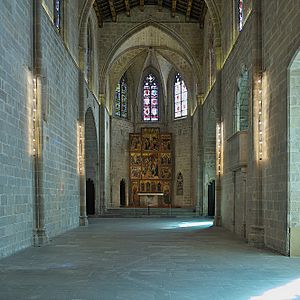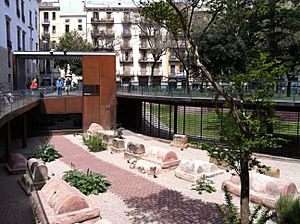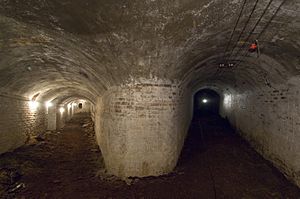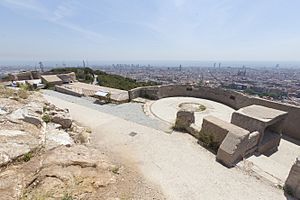Museum of the History of Barcelona facts for kids
| Museu d'Història de Barcelona (MUHBA) | |
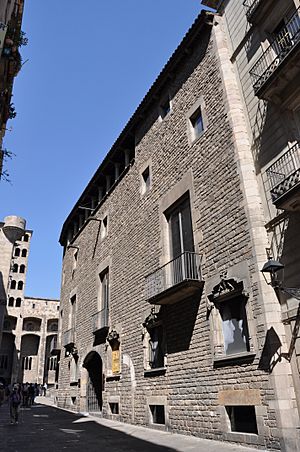 |
|
| Location | Casa Padellàs, Plaça del Rei, Barcelona (headquarters) |
|---|---|
| Type | History museum |
| Visitors | 816,989 (2018) |
| Owner | Barcelona City Council |
| Public transit access | |
The Museum of the History of Barcelona, also known as MUHBA, is a special museum that tells the story of Barcelona. It protects and shows the city's amazing history, from when it was a Roman town called Barcino all the way to today.
The main museum building is in the beautiful Gothic Quarter at a place called Plaça del Rei. But MUHBA is more than just one building! It's a network of historical sites all over the city. You can explore ancient Roman ruins, parts of the old Jewish quarter, and even buildings from modern times.
The museum first opened its doors on April 14, 1943. It is run by the Barcelona City Council and is a great place to discover how Barcelona became the city it is today.
Contents
How the Museum Began
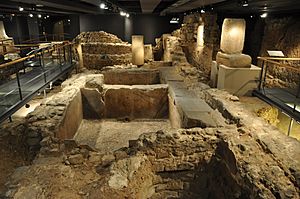
People had wanted a museum about Barcelona's history since the late 1800s. But it took a long time to make it happen. An important step was in 1931, when a historic palace called Casa Padellàs was moved. To save it from being torn down, it was taken apart stone by stone and rebuilt in Plaça del Rei.
A Surprise Discovery
While workers were rebuilding the palace, they found something incredible. Buried underground were the ruins of the ancient Roman city of Barcino! Archaeologists began to dig and uncovered a whole section of the old city.
The Spanish Civil War (1936-1939) stopped the work for a while. But the discovery was so important that everyone agreed this was the perfect spot for the new history museum.
Opening and Growing
The Museum of the History of Barcelona finally opened in 1943. At first, it focused on the Roman ruins and the medieval royal palace, the Palau Reial Major. Visitors could see the grand Saló del Tinell hall and the beautiful Saint Agatha chapel.
Over the years, the museum grew. It added more historic sites, like the ruins of a Roman temple and an old Roman cemetery. The museum also began to focus more on modern history, telling the story of how Barcelona grew into the big city we know today.
Explore the Museum's Many Sites
MUHBA is not just one museum, but a collection of amazing places across Barcelona. Each one tells a different part of the city's story.
Main Museum at Plaça del Rei
This is the heart of MUHBA. You enter through the Casa Padellàs and go down into a huge underground area. Here, you can walk through the streets of the ancient Roman city of Barcino. You can see where people lived, worked in laundries, and made wine. You can also see the remains of an early Christian church and baptistery.
Upstairs, you can visit the medieval Royal Palace. The main hall, Saló del Tinell, has giant stone arches. The chapel of Saint Agatha has a famous altarpiece painted by Jaume Huguet in the 1400s.
Roman Barcelona Sites
- Temple of Augustus: See four huge columns that are left from a Roman temple built to honor Emperor Augustus.
- Roman Sepulchral Way: This was a cemetery along a road that led into the Roman city. You can see old tombs and learn how Romans buried their dead.
- Roman Domus: A domus was a Roman house. You can visit the foundations of two different houses and see their beautiful mosaic floors and painted walls.
Other Amazing Locations
- MUHBA El Call: This site is in the center of the old Jewish quarter. It tells the story of the Jewish community that lived in Barcelona for centuries.
- MUHBA Park Güell: Inside one of the gatehouses designed by the famous architect Antoni Gaudí. You can learn about the park and see Gaudí's unique style up close.
- MUHBA Oliva Artés: This was once a factory. Now, it has an exhibit about how Barcelona changed from a small town into a modern city.
- MUHBA Air-Raid Shelter 307: Walk through over 200 meters of tunnels in this shelter. It was built during the Spanish Civil War to keep people safe from bombs.
- MUHBA Turó de la Rovira: Climb to the top of this hill for a 360-degree view of Barcelona. During the Civil War, anti-aircraft guns were placed here to defend the city.
See also
 In Spanish: Museo de Historia de Barcelona para niños
In Spanish: Museo de Historia de Barcelona para niños
- Flemish Clock - one of the exhibits


